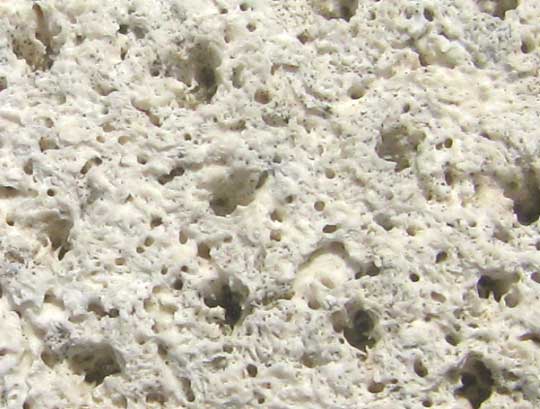Excerpts from Jim Conrad's
Naturalist Newsletter

from the May 22, 2011 Newsletter issued from Mayan Beach Garden Inn 20 kms north of Mahahual; Caribbean coastal beach and mangroves, ~N18.89°, ~W87.64°, Quintana Roo state, MÉXICO
SPONGIFORM FOSSILS
The rocky point just south of us has lots of fossils. There's a good fossil forum on the Internet where experts offer to identify your fossils, so I photographed a fossiliferous slab of limestone with my foot for scale and uploaded it. The picture is shown above.
Several kinds of fossils occurred there but I photographed the largest, best preserved ones I could find, thinking I'd start with something easy. I even took a close-up of the surface structure, shown below:

I was impressed with the forum. On a Sunday morning fifteen minutes after I'd uploaded my material the picture had been viewed 22 times and already I had two responses.
Piranha in the US wrote, "Excellent close-up. The diagnostic characteristics should be easy to deduce. I'm on it!"
In a couple of hours Piranha came back with, "They certainly appear to be dead ringer spongiform fossils. Unfortunately nothing is lining up in the literature."
The next day, the pictures having received over 100 viewings, among the responses were Piranha again, this time writing, "Having looked at a few hundred possible sponges in the treatise and now those corals from the Pleistocene ... I'm waving the white flag and crying uncle on this one. It could be either and this appears to fall in the category of: not on the visible radar... "
So, my easy fossil wasn't so easy. Piranha's diagnosis of "spongiform" didn't reveal much, since that term only means "shaped like a sponge." I'm amazed that they couldn't even determine whether what we have is a sponge, a coral, or something else.
The best I can tell from geological literature on the Internet, the rocks of our rocky points are probably Miocene-Pliocene in age -- 1.8 to 23 million years old. Therefore, our fossils shouldn't be too different from living organisms found now offshore. Yet here's a large, well-preserved fossil that's stumped the experts!
What a pleasure to be where so many of the everyday plants and animals around us -- living and extinct -- are poorly known or maybe even "unknown to science."